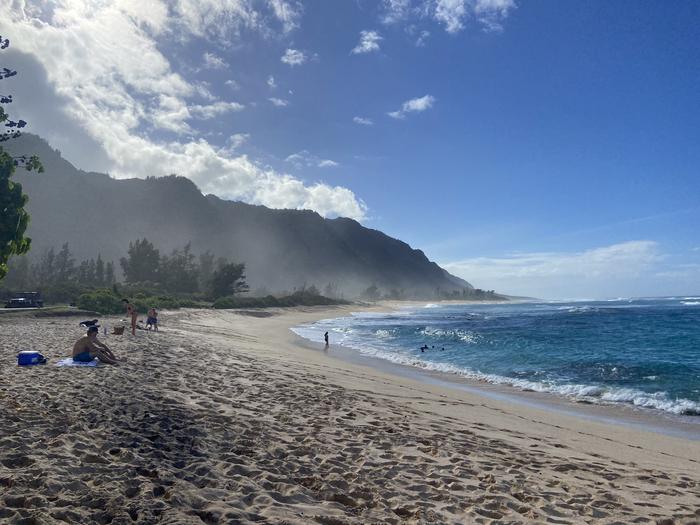Despite their tiny sizes, aerosols, such as sea salt, dust, and ash, play a giant role in shaping weather and climate. These particles scatter light, act as the starting point for cloud formation, and can even initiate or limit rainfall. A new study from atmospheric scientists at the University of Hawai‘i at Mānoa revealed that the coastline can produce up to five times the concentration of giant sea salt aerosols compared to the open ocean and that coastal clouds may contain more of these particles than clouds over the open ocean—affecting cloud formation and rain around the Hawaiian Islands.

Credit: Katie Ackerman
Despite their tiny sizes, aerosols, such as sea salt, dust, and ash, play a giant role in shaping weather and climate. These particles scatter light, act as the starting point for cloud formation, and can even initiate or limit rainfall. A new study from atmospheric scientists at the University of Hawai‘i at Mānoa revealed that the coastline can produce up to five times the concentration of giant sea salt aerosols compared to the open ocean and that coastal clouds may contain more of these particles than clouds over the open ocean—affecting cloud formation and rain around the Hawaiian Islands.
“Aerosol-cloud interactions and rainfall are among the biggest uncertainties in projections of future climate,” said Katherine Ackerman, lead author of the study and atmospheric sciences doctoral candidate in the UH Mānoa School of Ocean and Earth Science and Technology (SOEST). “Because freshwater is essential to the sustainability of life on the Hawaiian Islands, it is imperative to accurately predict where and how much it will rain as our climate changes.”
“The day-to-day rain from cumulus clouds is critical to replenishing our fresh groundwater, but the transition from cloud to raining cloud is still poorly understood, and therefore difficult to predict,” added Ackerman. “We hope this research helps improve predictions of rain generated by Hawaiʻi’s tradewind cumulus clouds so that we can better prepare Hawaiʻi in this changing world.”
Alison Nugent, associate professor of atmospheric sciences and senior author on the study, and her team developed a lightweight and affordable 3D-printed instrument that measures aerosol size distributions rather than only bulk aerosol concentration or mass, like many other methods of sampling. They attached the device to kites, fishing rods, and drones to sample how giant sea salt size distributions vary across different altitudes, locations from the coastline, and a wide variety of environmental conditions.
“Regular in situ observation of clouds is difficult because of the effort involved with reaching them,” said Nugent. “So instead, much of our current research has focused on the giant sea salt particles that Hawaiʻi’s clouds form on, and understanding the specific mechanisms that influence how they are produced, and where they are able to travel after production.”
Improving weather prediction
Waves breaking on the shoreline produce a mist which is made up of water droplets and giant sea salt aerosols. Those aerosols get carried towards the mountains by on-shore winds.
“Anyone who goes to the beach on Hawai‘i’s windward coastlines has probably seen these processes in action, even if they weren’t aware,” said Ackerman. “Even when you can’t see them anymore, the particles are still there, moving with the wind, and eventually up to the clouds.”
“We identified the coast as a major source of giant sea salt aerosols which is important in understanding how they impact our coastal clouds,” Ackerman added. “Their large size means they fall out of the atmosphere a lot faster than other aerosol types, so identifying their production locations is really important to quantifying their potential impacts on the local atmosphere.”
The researchers also found that wave heights were the biggest predictor of giant sea salt aerosol concentrations.
“This observation feels intuitive—larger waves breaking along the shore will produce more ocean mist,” said Ackerman. “However, most computer models have been using wind speeds to predict sea salt aerosol concentrations over the open ocean, and almost none recognize coastlines as an additional source.”
This finding can be used to improve numerical weather prediction of nearshore cloud formation and rainfall patterns across the Hawaiian Islands.
Journal
Atmospheric Chemistry and Physics
DOI
10.5194/acp-23-13735-2023
Method of Research
Observational study
Subject of Research
Not applicable
Article Title
Mechanisms controlling giant sea salt aerosol size distributions along a tropical orographic coastline
Article Publication Date
3-Nov-2023
COI Statement
The contact author has declared that none of the authors has any competing interests.




